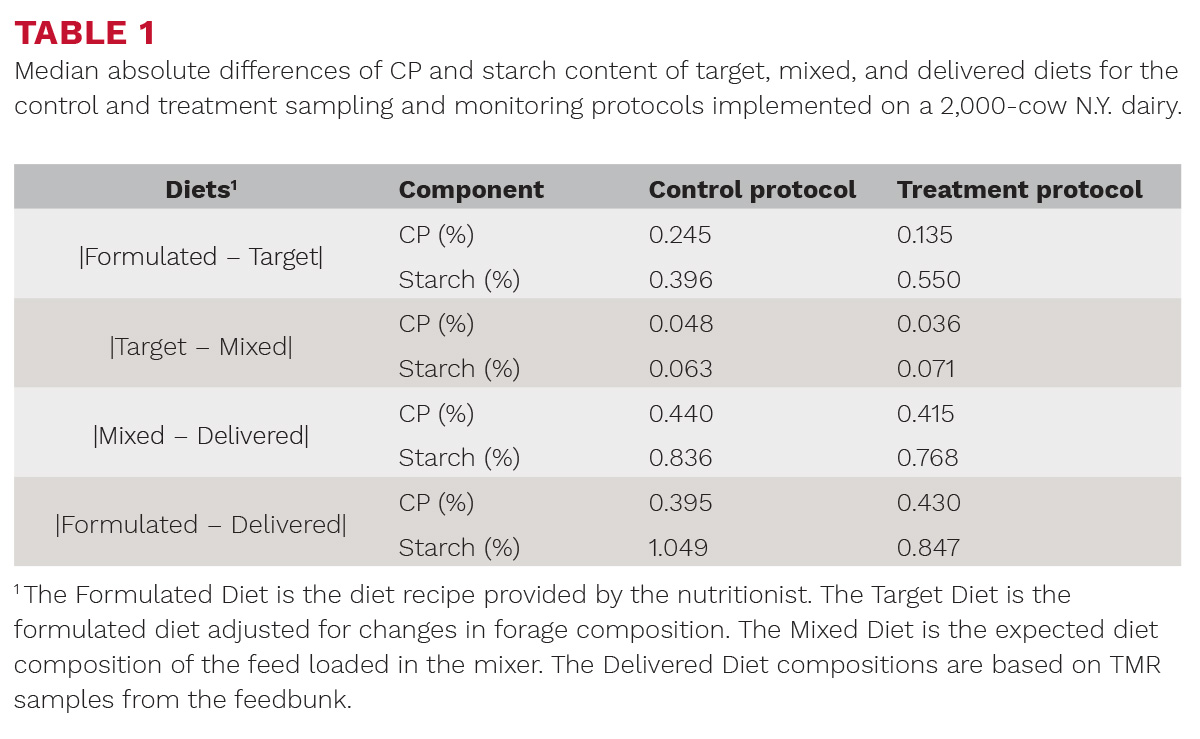Failure to detect and intervene in feed composition changes during the production and delivery of dairy cattle diets increases the uncertainty of the nutrients actually delivered which, in turn, increases the risk of underfeeding or overfeeding cows.
SOURCES OF VARIABILITY ON DIETS
Sources of diet variability include variation in the feed composition, sampling practices and laboratory analysis, diet mixing management, and feed delivery. Diet variability decreases the precision and accuracy with which we can meet cow nutrient requirements and can impact feed efficiency, milk yield, cow health, environmental sustainability, and profitability of dairy farms.
Among diet ingredients, forages are often the largest contributor to diet nutrient variability due to high variation in forage composition and high inclusion rates (40 to 60 percent). Additionally, forages are the ingredients with the highest deviation of loaded weights from the targeted weights at mixing.
We recently shared work that points to differences between silos and fields-of-origin as relevant sources of variability in corn silage neutral detergent fiber (NDF) and starch, and alfalfa-grass silage NDF and crude protein (CP) content. We also estimated that relevant changes in corn silage NDF and starch content can occur as frequently as every two to five days, depending on the farm size and feeding management.
For alfalfa-grass silage, NDF and CP content had meaningful changes every two to nine days. These findings suggest that developing forage sampling and monitoring protocols that can identify changes in forage composition for which diet adjustments will significantly improve diet accuracy has the potential to improve farm performance. St-Pierre and Cobanov (2007) proposed optimizing sampling practices using the renewal-reward-model (RRM) and genetic-algorithm (GA) and monitoring forages with quality control charts to minimize the costs incurred due to this variation.
Using the methodology described by St-Pierre and Cobanov (2007), we developed an application to optimize sampling protocols and monitoring forage components. Between May and August 2022, we applied this approach on a N.Y. dairy farm to measure the impact of optimal forage monitoring and diet reformulation on the accuracy of delivered diets, milk yield, and feed efficiency (FE).
METHODOLOGY TO EVALUATE ON-FARM OPTIMAL SAMPLING PROTOCOLS
Five multiparous cow pens (about 750 cows/pen, about 160 DIM on average) from a 2,000-cow dairy farm from New York were enrolled in the study for 16 weeks. Pens were blocked by milk production and assigned to either a control (business as usual) or treatment (optimal diet reformulation) protocol in a crossover design with two eight-week periods. We monitored corn silage and alfalfa-grass haylage by two independent samples every other day and set tolerance levels for the variation in the forage nutrient composition (control limits) as recommended through optimization of the RRM for the conditions on our case study farm. We confirmed a significant change in composition when the average composition was outside the control limits for two sequential sampling days. When a change in composition was confirmed, we requested that the farm nutritionist adjust the diet using the average of the samples collected on the two days that indicated a change in composition.
We calculated the composition of four different theoretical diets that represent different stages of the diet preparation and delivery process:
- The formulated diet
- The target diet
- The mixed diet
- The delivered diet
The formulated diet corresponds to the diet formulated by the nutritionist. The target diet corresponds to the formulated diet that is set to be prepared in the mixer. The nutrient composition of the target diet differs from the formulated diet due to changes in components of the ingredients over time. In this study, the nutritional composition of the non-forage ingredients was fixed over time. The mixed diet corresponds to the diet loaded into the mixer and reflects changes due to deviation in loaded weights and components variation of forages. The delivered diet composition was measured with two independent samples collected every other day from the feedbunk of pens in this study. To assess accuracy of the delivered diets, we calculated the absolute value of the difference in NDF, CP, and starch of the four different diets (i.e. Formulated Diet NDF – Target Diet NDF, Target Diet NDF – Mixed Diet NDF, and so on). Feed efficiency was calculated by dividing the individual cow milk yield by the average DMI of the corresponding pen. A generalized additive mixed effect model was used to estimate the effect of the treatment and control protocol on milk yield, FE, and DMI records.
EFFECTS OF OPTIMAL SAMPLING ON DIET REFORMULATION
During the 16-weeks of the trial, the diet managed with the treatment protocol had a median reformulation interval of every eight days based on changes in corn silage and alfalfa-grass silage composition. Of the 16 total diet adjustments in the treatment protocol, eight were associated with a change in the starch content of corn silage, and eight were associated with changes in haylage CP content. In contrast, the diet managed with the control protocol had a median reformulation interval of every 22 days. Changes to the diet formulation were left to the discretion of the nutritionist; however, diet adjustments followed similar patterns dependent on the forage type that signaled a shift. Specifically, when corn monitoring signaled a change in the starch composition, corn silage and corn meal inclusion rates were adjusted. Similarly, when the quality control chart signaled a change in alfalfa-grass silage, inclusion rates of alfalfa-grass silage and canola meal were adjusted.
EFFECTS OF OPTIMAL SAMPLING ON DIET ACCURACY
Reformulating diets based on changes in corn silage and alfalfa-grass silage compositions identified through increased sampling frequency and application of the quality control chart improved the accuracy of the targeted diet. The target diet CP of the treatment protocol was 0.11 percent CP closer to the formulated diet than the control protocol (Table 1).

Although half of the adjustments were initiated due to a change in corn silage, the calculated differences between the formulated and target diet starch contents were greater in the treatment protocol than in the control. The differences between the target diet and formulated diet compositions were larger than the differences between the target diet and mixed diet compositions (Table 1). The low values of the differences between the mixed and the target diet indicates that forage composition variability has higher influence on diet accuracy than the errors of loaded weights of ingredients at mixing. Laboratory analysis of TMR samples collected from the pens showed high variability in the measurements of the delivered diets for both treatments. This high variability likely reflects the high variability associated with sampling TMR from the bunk rather than a true metric of the composition of the diet delivered to the cows.
EFFECTS OF OPTIMAL SAMPLING ON MILK YIELD AND FEED EFFICIENCY
Results of the statistical analysis showed a tendency for our treatment protocol to increase (P <0.1) the marginal mean of milk yield by 1.08 kg/cow/d. However, the DMI of the treatment protocol (25.6 kg/cow/d) was not significantly different than the control protocol (25.2 kg/cow/d). In a simulation study on changing nutrient composition of three Californian dairy diets (-20% to +20 percent), Johnson et al. (2007) predicted that N and milk allowance were most sensitive to variation in diet CP, NDF, and soluble CP (SCP) content. Therefore, the improvement in milk yield in the treatment protocol can be more associated with the higher accuracy of delivered diet CP. Although our results suggest that higher accuracy in CP content of delivered diets increased milk yield without significant increase in DMI, the FE of the treatment protocol (0.83 kg milk yield/kg DMI) was not significantly different to the control protocol (0.82 kg milk yield/kg DMI).
TAKE HOME MESSAGES
1 Implementing optimal sampling and monitoring practices increased the frequency of diet reformulation, resulting in more accurate CP composition but less accurate starch composition of diets.
2 Variation of forage components showed higher impact on accuracy of delivered diets than the effects of errors in forages' loading weights at mixing.
3 Better accuracy of the delivered diet managed with optimal sampling and monitoring protocols did not significantly affect the DMI.
4 Pens with more frequent diet reformulation that resulted from our optimal forage monitoring protocol showed a tendency to increase milk yield by 1.08 kg/cow/day.
 |
This article appeared in PRO-DAIRY's The Manager in March 2024. To learn more about Cornell CALS PRO-DAIRY, visit PRO-DAIRY. |





